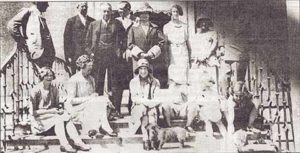Epidemic!
Roger Guttridge with the story of the tragic typhoid outbreak, eighty years on
Published in November ’17
On the front door of a house in Bournemouth, someone had placed a large yellow cross to warn people that the place was infected. The warning was so effective that even the baker and milkman stayed away. What no-one realised was that behind the door were three young children, alone and practically starving.
It was the summer of 1936 and the children’s mother and three siblings were hospitalised, early victims of a typhoid epidemic that was to become perhaps the area’s greatest health crisis of modern times. In six months, over 700 people were hospitalised and at least 71 died – possibly more because some victims were holiday-makers who had gone home before their symptoms appeared.
Edna Kearley was eleven when she, nine-year-old sister Eileen and their brother Stanley, eighteen months, found themselves alone in the Windham Road house. When I interviewed her in 1992, Edna (by now Mrs Travis) told me: ‘My father, a chauffeur, was in London and no-one realised we were alone. For five days we lived on stale bread and Oxo, which was all we had in the house. People were too frightened to come near and we didn’t go out because we’d been told not to.’
Once her father returned, Edna was able to visit her family in Boscombe Hospital’s isolation unit: ‘It was a traumatic experience, queuing outside the hospital gates,’ she recalled. ‘You would hear that certain people had not come because their relative had died.’
Edna herself was admitted to hospital in January 1937 – the epidemic’s 718th and last victim. ‘I vowed that if my family came through it, I would become a fever nurse when I was older. True to my word, I started at Boscombe Isolation Hospital in 1942,’ she said.
It was early August when the first trickle of people began consulting their GPs about gastric symptoms, but few doctors had ever seen a case of typhoid and the illness remained undiagnosed for weeks. By 20 August, the number of patients had risen to 315 and the man from the ministry was sent for. Within hours of his arrival, Dr W Vernon Shaw, one of the great epidemiologists of his day, had identified milk from Frowd’s Dairy at Poole as the common factor. Frowd’s 192 staff members were quickly exonerated.
Dr Shaw’s inquiries led him to milk from five smallholdings beside a stream at Merley, near Wimborne. A farmer’s wife and twelve-year-old son were already ill and she later died of typhoid. But Shaw calculated that she had contracted it too late to have been the source. Other evidence put the stream itself under suspicion, but five water tests proved negative. It was not until the sixth and seventh tests in October that the B. Typhosus bacterium was found. The trail led to a sewage tank at Merley House, which occasionally overflowed, hence the variation in test results. Captain Angus Hambro, MP, Merley House’s owner, was mortified to learn that he was the carrier. He’d travelled widely abroad and once suffered a severe fever, which now appeared to have been typhoid.
In 1996, fourteen survivors marked the sixtieth anniversary of their ordeal at, of all places, Merley House. A picture of them on the steps appeared in Nurse Mary Graham’s booklet on the epidemic in 1997. The reunion was the idea of Dennis Long, of Ferndown, who was a victim twice over. As well as contracting typhoid when he was ten, he was also the son of William Long, the owner of Frowd’s Dairy. ‘The whole business made my father bankrupt,’ he told me.

Typhoid carrier Angus Hambro MP (back row, second left) on the steps of Merley House with Prime Minister Stanley Baldwin (third left) and guests
Four-year-old Peter Coles of Poole had a glass of milk with his daily breakfast in 1936 but on one occasion refused to drink more than a few sips because it ‘tasted odd’. ‘My father felt he had to show me there was nothing wrong and drank the rest in one gulp,’ Peter recalled. Mr Coles should have trusted his son’s judgment. A couple of weeks later both were in Alderney Isolation Hospital with typhoid and Mr Coles almost died. ‘I had a fortnight in bed and when I got up, I couldn’t walk and was terrified,’ Peter said. He recovered and became Mayor of Poole in 1981.
Trainee ballet teacher Elizabeth Collins, eighteen, lived in Bournemouth but was on holiday on a farm in Shropshire by the time she was diagnosed. ‘No-one came up with the correct diagnosis for some time.
My own Bournemouth GP eventually hit on it,’ she said, ‘but not before there had been deaths. A school friend was operated on for peritonitis, proving fatal, of course. Tests at Ludlow confirmed my illness. The nearest hospital was 30 miles away and I had to have a full-time nurse and was kept perfectly still in case the intestines perforated.’ It was six weeks before Elizabeth returned to Bournemouth and a year before she could do ballet to her usual standard. Some health effects continued for the rest of her life. ‘On the plus side, I remained slim for many years and could wear marvellous clothes,’ she said. ‘But food was a problem. I had to start with small meals and no roughage – worse than a baby!’


